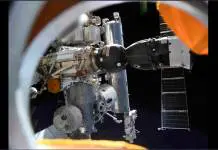NASA’S InSight Mars Lander has officially left Earth from Vandenberg Air Force Base, California, and has now taken a course towards the Red Planet, starting its 205-day trip at a speed of 485 million km per hour (301 million mph). The spacecraft was launched atop of the United Launch Alliance Atlas V Rocket on early Saturday morning at 4 am, being the first interplanetary mission to lift off from the U.S West Coast.
InSight separated from the Atlas rocket’s upper level about an hour after it departed for its mission, marking the official beginning of its journey to Mars. After it separated from the Centaur, NASA received a signal from their antenna at Goldstone, California confirming that the spacecraft was still in one piece and now interplanetary.
Throughout its course to the Red Planet InSight will undergo a testing process for 10 days after its launch, to ensure the spacecraft is fit for its deep study mission on the surface of Mars. Flight controllers will check out and calibrate InSights’s subsystems and tools. This calibration helps to orient the spacecraft’s antennas and solar arrays, which will keep in line its trajectory towards Mars.
Our #InSight lander will burrow 10 to 16 feet (3 to 5 meters) into the crust of Mars, going 15 times deeper than any previous Martian mission. Here are some trivia questions about the Red Planet and our missions to study it. pic.twitter.com/1cbwdArywy
— NASA (@NASA) May 5, 2018
What is InSight’s mission objective and how long will it last?
The spacecraft is set for a 7-month trip in which the correction maneuvers will take place. Liftoff controllers have said that some correction processes are skippable in case the initial injection is very good, and so far everything seems to be going alright. NASA’s InSight project manager told Space.com, “Some we will do just before entry, descent, and landing, just to make sure we are hitting the exact corridor for that successful landing”.
This pioneer spacecraft is set to study and monitor the Red Planet’s surface as well as its deep interior, being in charge of detecting heat levels and providing valuable information on different ways that humans could safely make it into the rocky planet. Once the lander makes it through Mars’s atmosphere, InSight will be scheduled to land by November 26.
There was a veil of fog flowing across Vandenberg at the time the robotic mission took off, which made it difficult for observers who gathered to see the Atlas 5 rocket give a ride to the InSight spacecraft. The Atlas 5 engine produced 860,000 pounds of thrust when fired yet the fog was so dense that most watchers couldn’t catch a glimpse of the launching.
Source: Space.com











